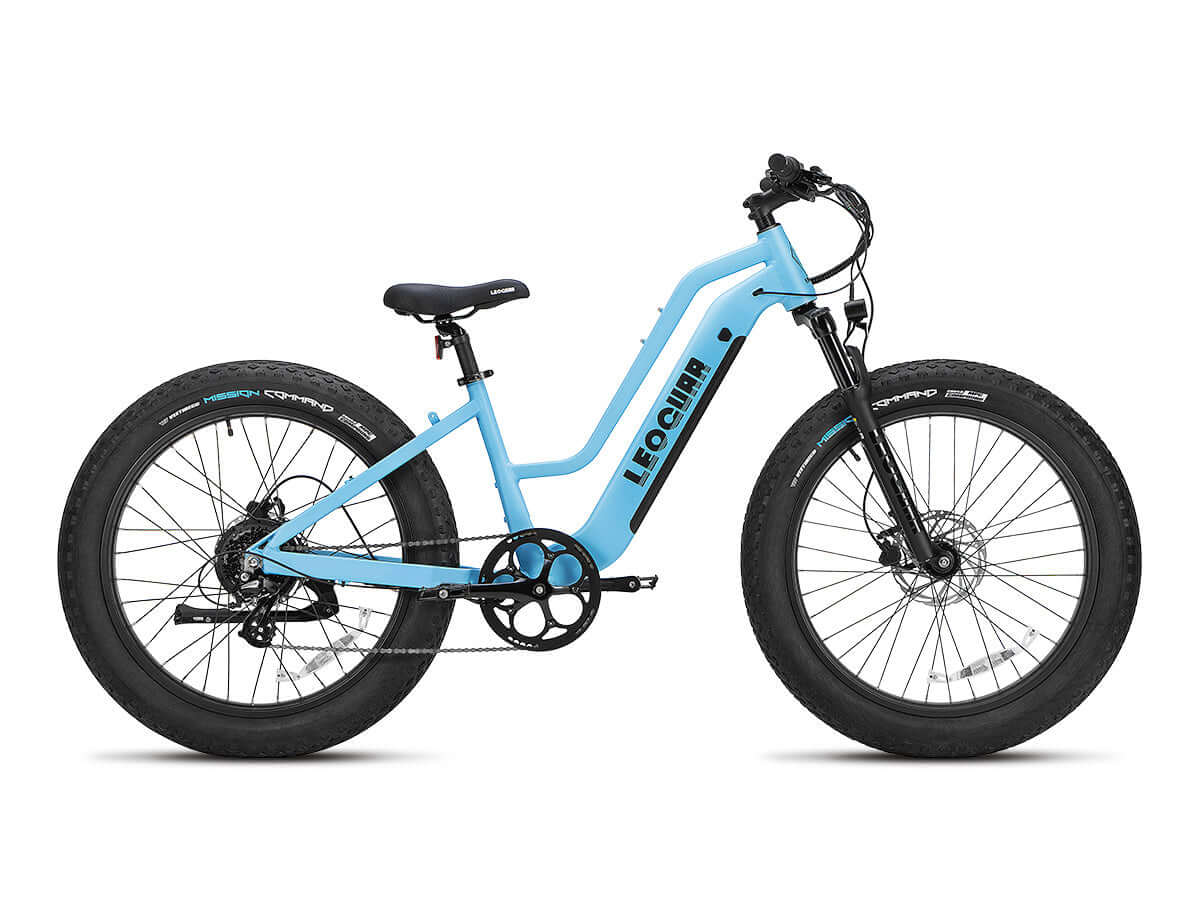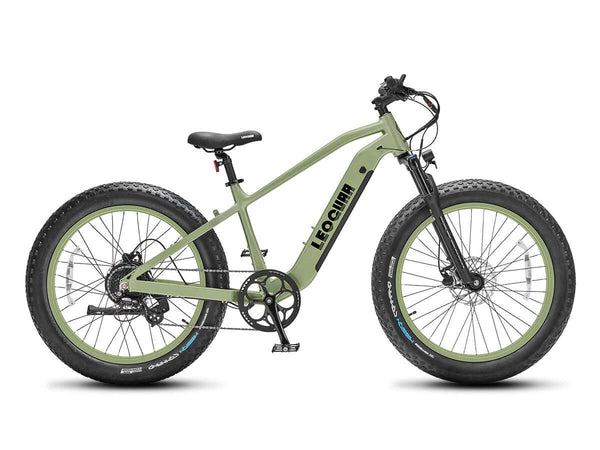
Why Choose a Fat Tire E-Bike? Comfort, Stability, and Grip Explained
Your All-Access Pass
The main reason to pick a fat tire e-bike is for its amazing flexibility and the confidence it gives you. These bikes work like an all-access pass to almost any ground, no matter what the weather is like. They rest on three main ideas: great comfort, strong stability, and powerful grip. A fat wheel electric bike, as people often call it, removes the limits you might think come with bike riding.
Don't worry about being stopped by sandy beaches, snowy paths, or rough city streets. This is not just a bike. It invites you to explore more, worry less, and ride with freedom that regular bikes just cannot give. It creates a new world of riding choices, changing problems into chances for adventure.
Comfort, Stability, and Grip
To really get why fat tire e-bikes appeal to people, we need to break down the three main benefits that make its ride quality special. These are not just sales words. They are real features that come from the bike's special design, mainly its big, low-pressure tires.
Your Personal Suspension
The first benefit you will feel is amazing comfort. The big amount of air inside a fat tire, which is usually 4.0 inches or wider, works like a natural shock absorber. Think about riding a regular bike over tree roots on a trail where you feel every bump shake up through the handlebars and seat.
Now think about the same situation on a fat tire e-bike. The tire bends and wraps around the roots, softening the hit. From what we have seen, this changes the ride completely. Cracked roads, gravel paths, and small holes that would normally jar you feel smooth. You are not bouncing over rough spots. You glide over them instead. This built-in cushioning reduces tiredness in your hands, back, and shoulders, letting you ride longer and more comfortably.
Ride With Unshakeable Confidence
Fat tires make a much wider contact patch, which is the area of the tire touching the ground. This makes a very stable base, like how a wider stance makes a person harder to push over. This stability changes everything, especially for new riders, those with balance problems, or anyone riding at slow speeds.
The difference shows most when stopping and starting, where the bike feels planted and secure, removing the shakiness that can make riders nervous. These tires usually range from 4.0 to 5.0 inches wide, a huge increase compared to the 2.0 to 2.5 inches of a standard mountain bike. This extra width creates unshakeable confidence, letting you focus on the joy of riding rather than worrying about keeping your balance.
Conquer New Surfaces
The mix of a wide, bendable tire and low air pressure creates strong grip. The tire shapes itself to the ground's curves, making the most surface contact and traction in a way narrow, high-pressure tires cannot. This lets a fat wheel electric bike conquer surfaces that are impossible for most other bikes. This game-changing grip opens up year-round, all-terrain adventures. Key examples include:
- Sand: Float over soft beach sand instead of sinking.
- Snow: Keep traction and control on packed snow or light powder.
- Mud: Power through muddy trails without the tires slipping out.
- Wet Leaves: Grip securely during slick autumn rides.
- Loose Gravel: Stay planted and in control on shifting surfaces.
Fat Tire Dynamics
The great performance of fat tires is not magic. It is physics. Understanding two key ideas, tire pressure and rolling resistance, shows why these bikes do well where others fail and proves wrong common myths about how efficient they are.
The Magic of PSI
With fat tires, lower pressure is often better. Unlike road bikes that need high PSI (80-120) for efficiency on smooth pavement, fat tires work at a much lower range (5-25 PSI). Lowering the pressure lets the tire bend and spread out, making that larger contact patch we talked about.
This is the secret to both floating on soft surfaces like sand and snow and shock absorption on bumpy ground. Changing your PSI is the easiest way to tune your bike's performance for the day's ride. Higher pressure gives less rolling resistance for paved paths, while much lower pressure provides maximum grip and cushioning for challenging trails.
| Terrain | Recommended PSI Range | Benefit |
|---|---|---|
| Paved Roads | 20-25 PSI | Lower rolling resistance, efficiency |
| Hard-Packed Trails | 12-18 PSI | Balance of grip and efficiency |
| Sand / Snow | 5-10 PSI | Maximum flotation and grip |
Rolling Resistance Realities
A common worry is that fat tires must be slow and hard to pedal because of high rolling resistance. On perfectly smooth asphalt, a high-pressure road bike tire will roll with less effort. However, this is only half the story.
First, the electric motor on a fat tire e e-bike completely removes any felt sluggishness. The powerful assist makes pedaling feel easy, turning the rolling resistance worry into a non-issue. Second, on rough terrain, things change.
According to extensive research into rolling resistance, a high-pressure, narrow tire constantly bounces off small bumps, causing it to lose forward momentum and create a rough, inefficient ride. In contrast, a low-pressure fat tire absorbs these same bumps, keeping momentum and providing a smoother, and often more efficient, ride on imperfect surfaces.
Real-World Applications
The technical advantages of a fat tire e-bike translate directly into a wider range of practical, real-world uses. It is more than just recreational equipment. For many, it becomes an important tool for commuting, fitness, and exploration.
The All-Season Adventurer
Perhaps the most exciting use is the ability to extend the cycling season through autumn and winter. When other bikes are put away, the fat tire e-bike is just getting started. We have had some of our most memorable rides on crisp winter days, gliding silently along snow-covered trails with complete stability and control.
The grip on light snow is remarkable, offering a unique and peaceful experience. Similarly, these bikes unlock destinations like sandy beaches or remote gravel roads that would be impossible to reach otherwise. It is the ultimate tool for the rider who refuses to be limited by the weather or the end of the paved road.
The Ultimate Urban Commuter
While born for the trail, the fat tire e-bike is surprisingly brilliant as an urban commuter. City streets are rarely perfect. The bike's natural comfort and stability make it a fortress on two wheels, easily handling common urban hazards.
Potholes that would rattle your teeth on a standard bike are absorbed. Cobblestones become a minor texture rather than a major obstacle. Slippery tram tracks and unpredictable construction zones are navigated with a level of safety and confidence that changes the commuting experience from a stressful chore into an enjoyable part of the day.
A Gateway to Fitness
The combination of stability and an electric motor makes cycling accessible to a much broader audience. For older adults, individuals with balance issues, or those just starting their fitness journey, the fat tire e-bike is a welcoming gateway. The stability removes the fear of falling, while the motor assist helps riders tackle hills and cover distances they never thought possible.
This encourages more frequent and longer rides, which is a fantastic way to build cardiovascular health and leg strength. It empowers people to explore their communities and local parks, but it is always wise to check local e-bike regulations to understand where you can ride.
Key Considerations
A fat tire e-bike offers incredible benefits, but it is important to have a balanced view. Its unique design comes with certain trade-offs. Understanding these will help you decide if it is the right choice for your lifestyle and needs.
The Trade-Offs
While the advantages are significant, you should be aware of the compromises built into the design.
- Weight and Portability: These are heavy machines. With robust frames, large wheels, and a motor and battery, a fat tire e-bike can easily weigh 30kg (65 lbs) or more. This makes carrying one up a flight of stairs or lifting it onto a car rack a significant challenge.
- Agility and Nimbleness: The same wide tires that provide stability also make the bike less nimble. It will not carve through tight corners with the precision of a road bike or a lightweight mountain bike. Think of it more as a stable, confident cruiser than an agile racer.
- Storage: The name says it all. A fat bike is big. The wide handlebars, long wheelbase, and chunky tires require more storage space in a garage or apartment than a standard bicycle.
The Ideal Rider Profile
A fat tire e-bike is not for everyone, but for certain riders, it is the perfect solution. You are an ideal candidate if you fit one of these profiles:
- The Comfort-Seeker: You find traditional bike saddles and riding positions harsh and uncomfortable. You want a bike that puts a smooth, cushioned ride over all-out speed.
- The Year-Round Rider: You live in a region with four distinct seasons and do not want to stop riding when the weather turns cold or snowy. You see commuting or recreation as a 365-day-a-year activity.
- The Explorer: You crave freedom and versatility. You want a single bike that can confidently handle your daily commute on pavement, a weekend trip on a forest trail, and a vacation ride on the beach.

The Final Verdict
Ultimately, choosing a fat wheel electric bike is a decision in favor of freedom, confidence, and versatility. We have seen how its core benefits of comfort, stability, and grip are not just features, but the foundation of a completely different riding experience. By understanding the physics of its low-pressure dynamics and seeing its real-world applications from all-season commuting to accessible fitness, it becomes clear what this bike truly offers.
It is more than just a different category of bicycle. It is your ticket to unlocking a new kind of ride, one with fewer limits and far more possibilities.
Frequently Asked Questions
1. What is the main difference between a fat tire e-bike and a regular e-bike?
The main difference is the tire width. Fat tire e-bikes have tires that are typically 4.0 to 5.0 inches wide, compared to 2.0 to 2.5 inches on regular bikes. This creates better comfort, stability, and grip on various surfaces like sand, snow, and rough terrain.
2. How much air pressure should I use in fat bike tires?
Fat bike tire pressure depends on the terrain you are riding. For paved roads, use 20-25 PSI. For hard-packed trails, use 12-18 PSI. For sand or snow, use 5-10 PSI for maximum grip and flotation.
3. Are fat tire e-bikes harder to pedal than regular bikes?
On smooth pavement, fat tires do have slightly more rolling resistance. However, the electric motor completely makes up for this, making pedaling feel effortless. On rough terrain, fat tires actually roll more efficiently because they absorb bumps instead of bouncing over them.
4. Can I ride a fat tire e-bike in winter conditions?
Yes, fat tire e-bikes are excellent for winter riding. The wide tires provide great traction on packed snow and light powder. Lower tire pressure helps the tires grip better on slippery surfaces, making winter commuting and recreation possible.
5. How much do fat tire e-bikes typically weigh?
Fat tire e-bikes are heavier than regular bikes due to their robust frames, large wheels, motor, and battery. They typically weigh 30kg (65 lbs) or more. This makes them less portable but more stable and durable for various riding conditions.










































Leave a comment